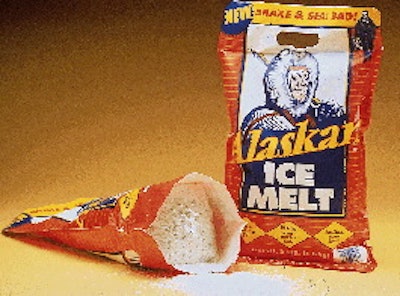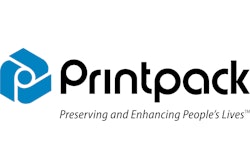Packaging for products sold at retail always makes a strong showing in the Flexible Packaging Assn. awards competition. This year was no exception as three of the eight winners for 1997 are marketed through retail outlets. (For a look at other FPA winners, see stories on p. 34 and 58). One is a pet food package produced on a first- of-its-kind vertical form/fill/seal system in the U.S. The pet food marketer is Hill's Pet Nutrition of Topeka, KS. Last spring Hill's introduced in Canada a flexible bag for its Hill's Science Diet® dry pet foods for cats and dogs (1). By last fall, the package was available throughout the U.S. The product is also exported from the U.S. to markets in the Pacific Rim, South America and Latin America. A European plant produces for nearby markets. Hill's and converter Printpack (Atlanta, GA) developed the structure over a 31/2-year period to replace a multiwall kraft paper bag. While the layer-by-layer composition is deemed proprietary, it's described basically as a polyethylene-based structure with a polyester exterior layer that's reverse-printed flexographically in five colors. By switching to the Printpack film, Hill's is enjoying a host of benefits. Economically, the new structure provides material savings of nearly 40% compared to the multiwall bag. Part of the savings is gained by using rollstock instead of pre-made bags. The flexible bag is formed, filled and sealed on equipment from UVA-Butler (Richmond, VA). Another key advantage provided by the new package is its ability to withstand distribution rigors. "Paper had a tendency to crease during distribution, so it didn't look as good as it could have on the shelf," says Paul Pezzoli, director of packaging technology for Hill's at the time of the change. He points out that these products sell at pet food warehouse outlets, pet stores and veterinarian's offices, but not mass-merchandise or grocery stores. Suggested retail prices range from $6 to $9 for some 15 SKUs of the products, including 4-lb quantities for cats, 5-lb sizes for dogs. While material costs savings, distribution advantages and improved shelf appeal made the new film structure terribly appealing, the company had to make sure the replacement package didn't have any serious down sides. Odor, for instance, was a primary concern. "Animals have extremely sensitive organoleptic senses," says Pezzoli, "and if they smell something they don't like, they'll turn their noses up at it." So, considerable testing was conducted to make sure the new materials wouldn't contain any such aromas that might dampen Kitty's or Fido's appetite. First-time application The new package is formed on three unusual UVA-Butler XL-460 machines. Hill's is the first U.S. plant to use the equipment. While the XL-460 performs the functions of a vertical form/fill/seal machine, it is also equipped to produce the nearly box-like appearance that makes the pack distinctive. The shape comes primarily from the flat, "block bottom", and four "pleated" side seals. Compared to the former equipment that filled the multiwall bags, "we're more efficient with this machinery," Pezzoli says. "With the old systems we had downtime, and changeovers took hours. With these, in 15 minutes or so, we can change the filling tube and we're ready to take on another product. That's important because plants often are producing to order, so sometimes changeovers have to be done quickly. When you factor in downtime for changeovers and maintenance, efficiency has increased significantly with these machines." Pezzoli wouldn't comment on machine payback, but he indicated it met the accepted guidelines of Hill's parent company, Colgate-Palmolive. Importantly, retail outlets have responded enthusiastically to the new pack, according to Colgate-Palmolive. Tyson goes reclosable route Another FPA winner uses a transverse zipper to make its bag a stand-out performer for family sized packs of frozen poultry in supermarkets and club stores. Take a gander at these outlets and it's pretty obvious that reclosable zippers are popular. Well aware of the consumer appeal of reclosability, Springdale, AR-based Tyson Foods wanted to add a zipper to the packaging of some of its cooked, frozen products. The zippered packs (2) were introduced last fall for packs destined for both club stores and supermarkets. Trouble was, the plants that produced these products didn't have the appropriate zipper applicating equipment, or they lacked the space to install such machinery. The solution, Inno-Lok(TM), is a zipper that is applied to the film by the converter. The technology allows the use of the same vertical form/fill/seal equipment used previously while providing the packs with the reclosable zipper. The monolayer 3-mil low-density polyethylene film is flexo printed in up to eight colors, depending on the Tyson product variety, by Pac One (Dunwoody, GA), formerly known as Polyflex Film and Converting. Pac One was the first converter to use the Inno-Lok machine from FMC (Green Bay, WI). What makes this zipper unusual is that it's applied to the inside of the front panel of the bag. The zipper is part of a 11/2" wide strip of film. In the Inno-Lok process the front panel of the bag is perforated around an "E-Z Tab." When the consumer pulls on the tab, the perforation tears and the zipper opens. Conventional zippers are applied across the top or along a side, with a male profile on one panel matching the female profile on the facing panel. Most zippers extend across the full width or length of a package, but the Inno-Lok zipper length can vary. In Tyson's case, an 8"-long zipper is centered in a 101/2" panel. "It's definitely different, and not a traditional zipper," admits Cary Richardson, vice president of marketing for Tyson's wholesale club business. "We initially had a concern about the consumer's ability to reach into the bag, but we feel the bag represents a quantum leap for the products versus not having a zipper at all. And from a production standpoint, this zipper gave us the ability to put a zipper on a package without having to shift production from one location to another. And while there was a learning curve in using film that was thicker due to the zipper, no new filling equipment was necessary." The process of applying the zipper to the film is patented, according to Jim Yeager, president of Innoflex (Alpharetta, GA). Innoflex and FMC formed a partnership in late '96 to produce the machine for flexible packaging converters. The zipper profile is supplied by MiniGrip/Zip-Pak (Manteno, IL). For club store sales, five products, in 4-lb to 6-lb packs, sell in the new bag. Prices vary between $6.99 and $9.99. These are frozen, fully cooked offerings, primarily chicken wings. Jeff Sandore, vice president of retail marketing, says a similar Inno-Lok bag is also used for three fully cooked chicken breast products, and one beef offering, all in 18-oz portions. Suggested retail price, he says, is $7.49. Like their wholesale club counterparts, retail bags are also vertically formed, filled and sealed. Pass the salt...shaker While a zipper helps keep Tyson's packaging competitive, a different zipper serves as part of an unusually functional pack for another FPA winner. The ShakerPAK(TM) for Pursell Industries' Alaskan Ice Melt (3) is about as practical as a package can get. The "Shake & Seal" bag instructs the user to cut along a dotted line near the bottom of the bag. Doing so reveals an inner mesh-like gusset that permits the user to shake salt out the bag bottom while holding the bag by a die-cut top handle. A reclosable zipper strip allows the pack to be easily and neatly reclosed. The patented ShakerPAK is converted by Kapak (Minneapolis, MN), using films from multiple suppliers. The 7.5-mil adhesive lamination includes an inner 6-mil linear low-density polyethylene layer/1-mil of nylon/48-ga polyester. Kapak reverse-prints the polyester by gravure, in four colors. The mesh gusset material is a 4.5-mil LLDPE film that's heat-sealed to the printed film by Kapak during the bagmaking process, at which time the zipper is also applied. Kapak then ships bags to Sylacauga, AL-based Pursell Industries. According to Judy Johnson, Pursell's purchasing agent for packaging, the 8-lb pack, available since last fall, replaces the previous 10-lb plastic bag. "We were looking for something that would be unique and user-friendly, a bag that could be used easily," she says. "And we're thrilled with the differentiation the pack gives our product." Unfortunately, most retailers were already stockpiled with all the ice melt compound they could handle this year, so sales have been limited. Johnson also tells Packaging World that the new bag costs 50¢ more than its predecessor. Its convenient shake and reseal features, she says, "have us excited about future sales."






























